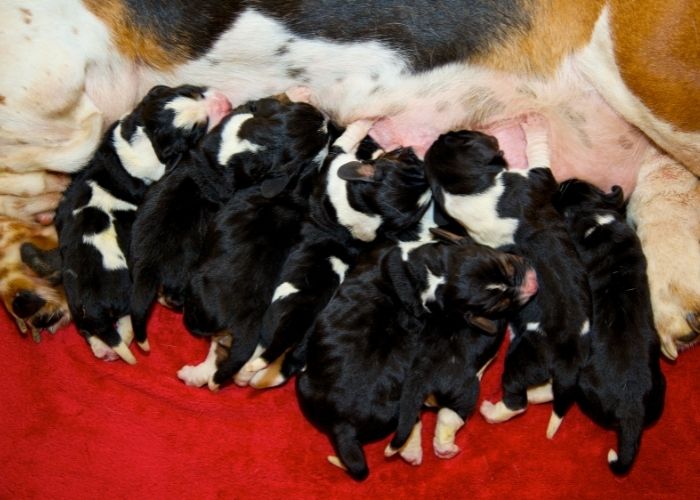Last Updated on November 11, 2023 by Linda Richard
Having a pregnant dog is both a joyous and stressful experience. It’s also full of unknowns. For example, what’s the average Labrador litter size – what to expect? Also, is your dog going to be fine through the pregnancy and the labor? How can you help and make sure that the whole thing goes smoothly? We’ll try to address those and most other related questions below.
Table of Contents
What Is The Average Labrador Litter Size?
First things first, how many pups can you expect? The average litter size for a Labrador Retriever is typically between 5 and 10 puppies. The largest recorded lab litter is 15 pups, but anything above 10 is generally very rare. Still, even 10 is a lot. Many lab owners never see a 10-pup litter, however, because the first litter of any dog tends to be on the smaller size. And, as many dog owners spay their dogs after the first birth, they don’t get that many pups.
How Many Puppies Can A Lab Have In A First Litter?
The first litter of any dog will be in the 1 to 5 range rather than 5 to 10. A larger first litter is still possible, of course, but it is unlikely. As for single-pup pregnancies – many are under the illusion that these are incredibly rare. They are not. Granted, 3-5 pup first-time pregnancies are more common, but 1-pup births are certainly more common than 10-pup ones.
In short – if you’re hoping for a larger than average Labrador litter size before you spay your dog, you’ll most likely need to go through more than one pregnancy. On the other hand, if you just want to have a couple of pups from your dog before you spay her, the fact that the first litters are smaller is perfect for that.
Is It A Problem If Your Lab Only Has One Puppy?
Typically, no, but there may be some issues to watch out for. Especially for younger dogs (read – just under one year), one-pup pregnancies can even be viewed as common. However, it is wise to consult with your vet before the pregnancy or in the early days.
One of the few issues that can arise with such a “singleton pregnancy” is insufficient labor hormones. This happens because a single pup is sometimes not enough to trigger the mother’s system to start releasing the labor-inducing hormones. If this happens, a C-section will be necessary to get the pup out.
Another common issue that also necessitates a C-section is that singleton puppies are often larger than normal. This is quite understandable given that a single pup tends to get more nutrients and more space to grow in the womb. If this happens, even if the mother goes into labor, it’s possible that she won’t be able to push such a large pup out. Hence – the C-section.
Simply put, while singleton pregnancies are normal for younger dogs and often go without a hitch, you should be ready in case there’s trouble. Your vet will brief you on everything you need to have prepared, of course. But it’s also wise to have your car ready to go in case you need to urgently go to your vet for a C-section.
Is The Lab’s Standard Litter Larger Or Smaller Compared To Other Breeds?
A 5 to 10 average litter size is on the bigger side of things in the canine world. This is normal for a large breed, however. Bigger dogs tend to have larger litters than smaller ones for obvious reasons. So, a Labrador litter size of 5-10 is larger than average but isn’t even that large compared to other breeds. The really large/giant dog breeds regularly birth up to 12+ pups at once.
Labrador Pregnancy – What Can You Expect?
Labrador Retrievers are a healthy breed and don’t have any specific pregnancy-related health issues. Of course, you should consult with your vet ahead of time to make sure that your dog is healthy. But, generally, your lab should go through the pregnancy without a hitch. The birth itself can be stressful, of course, so you need to be prepared for that.
How Long Does A Lab’s Gestation Last?
The gestation period for Labradors is on par with other breeds – anywhere between 57 and 65 days with an average of about 63 days. Everything up to 56 or 66 days would be considered normal as well, but you’d do well to talk with your vet for anything outside this range. In other words – the gestation period should be 2 months, take or leave a few days.
Do keep in mind that pregnancy can remain completely unnoticed for weeks, however. It’s perfectly normal for the first 4-5 weeks of the gestation period to go without any visible physical or behavioral change. The sacs will start getting noticeably big between the 21st and the 35th day of the pregnancy, which is one of the main signs. So, you likely won’t have two months to prepare but just about a month instead.
How Old Does A Female Lab Have To Be To Get Pregnant?
A lab can typically get pregnant right after its first heat or around her 8th month. It is recommended to wait for one or two heat cycles to pass before you try breeding your dog, however.
Do Labradors Often Have Pregnancy-related Problems And What Are They?
As we mentioned, labs aren’t subject to any breed-specific pregnancy-related problems. There are a few common pregnancy complications in all dog breeds, however:
Consult with your vet about any of these as well as about your dog’s vaccination status as pregnant dogs can’t get vaccinated.
In Conclusion, What’s The Average Labrador Litter Size And How Should You Prepare For The Birth?
Labs tend to have fairly large litters of 5 to 10 pups at a time, especially after the dog’s first pregnancy, which is usually smaller. All this is pretty normal, and labs generally go through their pregnancies and births without much trouble. Of course, you should be prepared for anything, especially if you know that your dog has certain health concerns anyway.



1 thought on “Average Labrador Litter Size – What To Expect?”
Comments are closed.